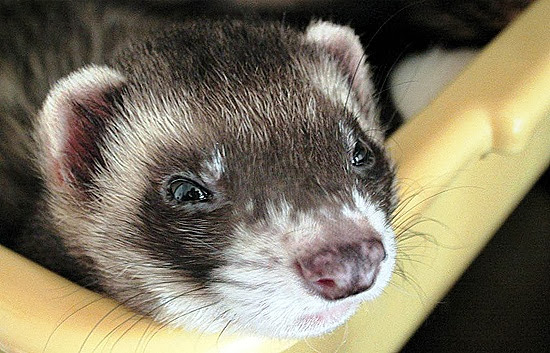
Though domesticated for millennia, the quirky little ferret has only been popular as a pet for about 30 years. Although they resemble rodents, ferrets are actually members of the carnivorous mustelid family, alongside otters, weasels, minks, badgers, and wolverines. They are endlessly interesting creatures with a long history of hunting, manufacturing airplanes, and participating in one of the most bizarre blood sports in the world.
10. Ferret-Legging
In various places throughout the world, an ancient, horrifying sport has made a resurgence. Ferret-legging is an endurance event wherein participants drop two live ferrets into their pants, which are cinched off at the ankles and waist. The animals claw and bite fiercely in an attempt to get free. The winner is the man who can withstand this torment the longest. One of the biggest “names” in the sport is Reg Miller of England, who introduced the concept of wearing white pants, to better display the blood spilled from bites. One of the key rules of ferret-legging of course is that participants are not allowed to don underwear. Up until the last few decades, records stood at less than a minute, but in 2010, the record was shattered by two men who kept the ferrets in their pants for a record 5 hours and 30 minutes.
9. Weasel War Dance
For those unfamiliar with ferrets, the so-called “weasel war dance” could be rather off-putting. With its back arched, the ferret will hop about in a frenzy, its tail puffed out. It often makes strange hissing noises. While normally quite agile, during this phase they tend to knock into things and topple over clumsily. This display might seem like the ultimate expression of ferocity, but it is really just an invitation to play, much like a dog will wiggle around when its leash or a favourite toy is produced. However, in wild species like stoats and other weasels, this “dance” is actually used to transfix prey such as rabbits. After a few moments, the much faster rabbit is captivated by the bizarre motion, and cannot react fast enough to flee when the weasel goes in for the kill.
8. Hunting
While they might be new to pet stores, ferrets have been domesticated for over 2000 years. A hunter would travel afield with his animals in a small cage or pouch, and upon sighting a rabbit warren, would let the ferret crawl inside. A few moments later, the rabbit would burst from another hole, the ferret in hot pursuit. From there, the hunter might shoot it or send fleet dogs like lurchers after it. For centuries, such practices were a vital lifeline for people trying to feed their families, but today it is largely done for sport or for controlling the rabbit population, which can quickly rise to destructive vermin levels if left unchecked. Often, the hunter will gut the rabbit and feed it to his ferrets, as they are a much better source of nutrition than commercially available foods. As one can imagine, there are many detractors of this pastime, with many claiming it to be a barbarous relic of the past.
While ferreting is nearly unknown in the United States, ferrets have been used there, primarily in the west, for protecting grain stores from rodents. Although not significantly smaller, a rat stands very little chance in a battle with a ferret. This predator kills by delivering a bite to the base of the neck, where the skull and the spine meet. While cats might be seen to reign supreme in the arena of mousing, the small and sinuous ferret can get into places that the cat cannot, worming its way inside walls and tiny dens where rodents secrete themselves.
7. As Pets
Despite their savage history, in general, ferrets make excellent pets. They are very intelligent, and can be trained to do all sorts of tricks. Like cats, they will use a litter box. While most members of the mustelid family prefer to live a solitary existence, coming together only for mating purposes, ferrets prefer company. They are happiest when there is at least one playmate in their cage. A group of ferrets is called a “business,” and they can be very entertaining to watch.
Ferrets are rather more high maintenance than a hamster or a gerbil. While they can spend the majority of their time in a cage, they require a good deal of interaction. They are inclined to several medical conditions, especially adrenal disease and intestinal blockages (earned from their habit of gobbling inedible items). They also have a strong natural musky smell that can be objectionable to some people.
6. Bans On Ferrets
Despite their popularity, there are many places where it is illegal to own a ferret, including New York City and the state of California. The most obvious risk is that pet escapees might form feral colonies and threaten wildlife. There are several populations of feral ferrets throughout the world. One of the most destructive is located in New Zealand, where they were imported, along with weasels, to control the exploding rabbit population (also imported). Unfortunately, the ferrets found the local ground nesting birds (which had evolved largely in the absence of predators) far easier to devour than the rabbits. The ferrets also pose a significant risk to New Zealand’s cattle industry, as they can carry a form of bovine tuberculosis.
While the vast majority of ferrets sold in the pet trade are already spayed or neutered, there remains concern that feral breeding populations may become established. The ferret is also a vector for disease - they can carry all the same afflictions as a cat or dog, including heartworm, rabies, and canine distemper. Ferrets are also particularly susceptible to the flu. Researchers discovered that the H7N9 avian flu, which has been making deadly rounds in China, passes easily between ferrets kept in close quarters.
5. In Art
The precise timeline of ferret domestication is unknown, but by the Middle Ages, they were well established throughout Europe. Art from this period frequently displays the animals. The most famous such work is undoubtedly Leonardo da Vinci’s Lady with an Ermine. The painting is a portrait of Cecelia Gallerani, who served as the mistress of Ludovico Sforza, the Duke of Milan. Ermine is actually the name for the short-tailed weasel or stoat in its winter phase (during the winter, it grows a completely white coat to camouflage itself into the snowy background). It is known as a symbol of royalty, which would explain the title. However, the animal featured in the painting is undoubtedly a ferret, likely a large male. A short-tailed weasel is a tiny creature, with the largest specimens weighing just over a quarter of a kilo (half a pound), while the “ermine” in da Vinci’s portrait is nearly the size of a cat.
4. Running Wires
Photo credit: Timur.Ka
The majority of “working” ferrets are used to eradicate vermin, but they have other, less obvious purposes. Their ability to worm their way through confined spaces has led several institutions to use them for running wire. In the 1960s, aircraft manufacturer Boeing used ferrets to string wire through planes. They were also used to run cable at Buckingham Palace for the 1981 nuptials of Prince Charles and Princess Diana. Ferrets were also used to lay cables in tunnels underneath Greenwich Park to save London’s New Years’ Eve Millennium Concert. The ferrets were encouraged to scamper through the tunnels with bits of meat baiting them at the other end.
The photo above is of “Nibbler,” who helped with the wiring of the Large Hadron Collider.
3. Colours And Waardenburg Syndrome
The vast majority of ferrets are either albino (white with pink eyes) or sable coloured like their wild polecat ancestors. Those using ferrets for hunting purposes favoured an albino animal, as it was easier to spot while out in the field. The sable can range in hue from the softest beige to very dark grey.
In recent years, ferret breeders have begun producing animals with designer colour patterns, like “badger” and “panda”. Unfortunately, these patterns make the ferrets more susceptible to developing a congenital defect called Waardenburg syndrome, which causes the skull to broaden and causes deafness. Most ferrets that have a white blaze or stripe on their head are at least partially deaf. Deafness causes a significant challenge to pet owners, as these animals can be difficult to train and are more likely to bite after being startled.
2. Hybrids
As the grey wolf can interbreed with the domestic dog, ferrets and European polecats can readily produce offspring. There are some polecat-ferret hybrids living in the wild in the UK, and some hunters prefer to use them over pure ferrets, who have lost some of their predator edge through domestication. Ferrets and polecats can also interbreed with the European mink. Because they are not as closely related, the male offspring of this arrangement are sterile, though females can breed. The resultant animals more closely resemble ferrets/polecats, but they share the mink’s affinity for water. Unfortunately, this situation is deleterious for the mink, which is critically endangered, and only found in a few small pockets throughout Europe.
1. Danger
Although an angry ferret can give you a bite you won’t soon forget (their teeth are razor sharp and they cling on tenaciously), they pose little real danger to adults. However, there have been some horrifying incidents where ferrets have attacked and even killed infants. In June of 2000, a pair of pet ferrets attacked a 10-day-old girl in Eau Clair, Wisconsin while the baby’s mother was napping. The child might have died if the family dog hadn’t leapt to the rescue. Luckily, her wounds were superficial and didn’t require stitches.
On January 10, 2011, emergency personnel responded to a home in Grain Valley, Missouri to a gruesome scene. A four-month-old boy left alone in a rocker had been savaged by a ferret. He only had his thumbs and a bit of pinkie finger left - the rest of his fingers had been chewed off. The boy’s father later pleaded guilty to second-degree child endangerment, a misdemeanour. The mother was sentenced to two years’ probation and 30 days in rehab.
Sadly, there have also been deaths, including 10-week-old Vivian Bettencourt of Hillsboro, Oregon, who was killed by a ferret in 1991. In nearly every case, the situation has been caused by parental neglect. Some experts have suggested that because infants reek of milk, ferrets view them as a prey object.
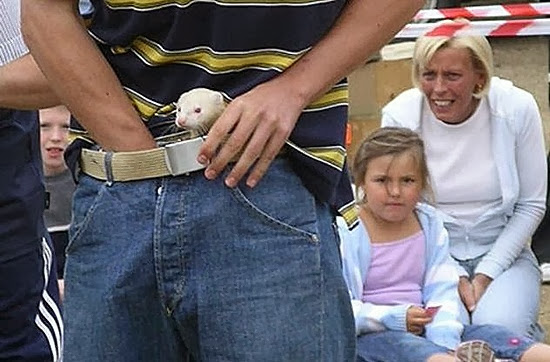
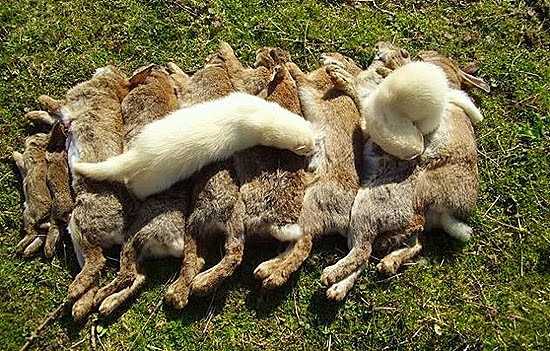
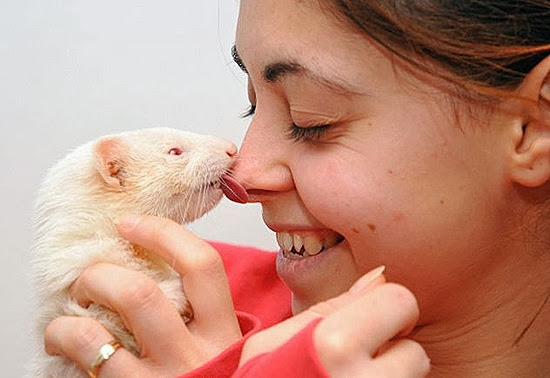
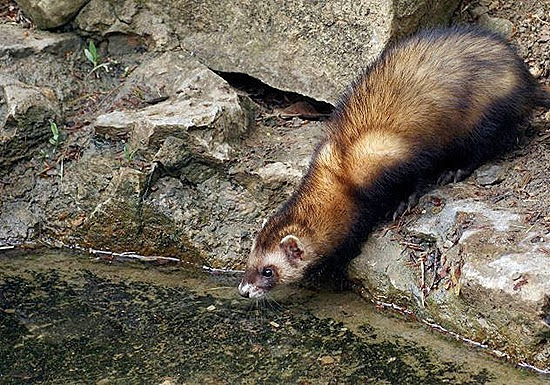
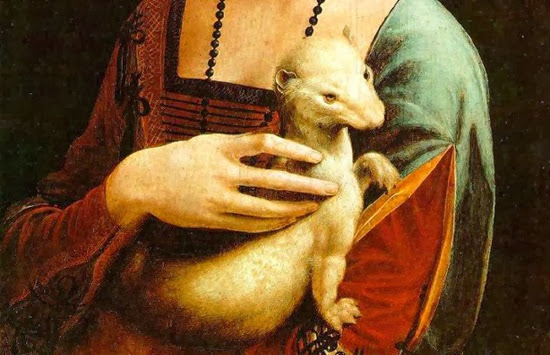
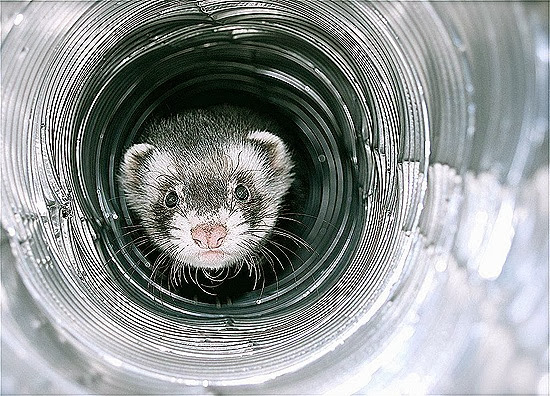


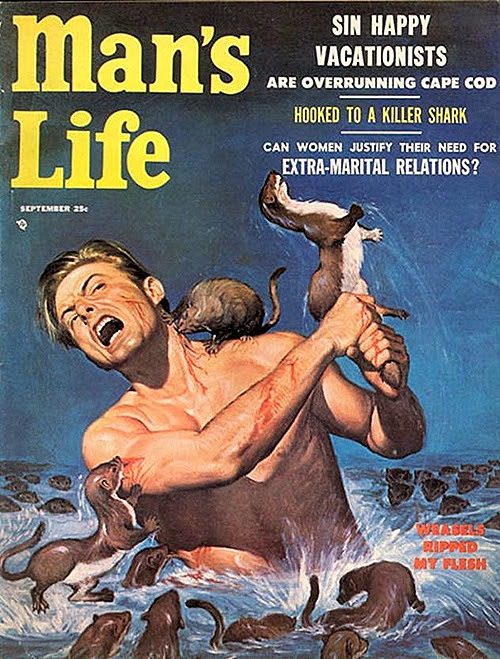
No comments:
Post a Comment
Please adhere to proper blog etiquette when posting your comments. This blog owner will exercise his absolution discretion in allowing or rejecting any comments that are deemed seditious, defamatory, libelous, racist, vulgar, insulting, and other remarks that exhibit similar characteristics. If you insist on using anonymous comments, please write your name or other IDs at the end of your message.